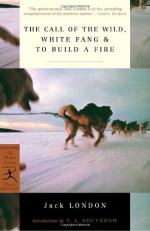|
This section contains 3,769 words (approx. 13 pages at 300 words per page) |

|
SOURCE: “Jack London's Twice-Told Tale,” in Studies in Short Fiction, Vol. 4, Summer, 1967, pp. 334–41.
In the following essay, Labor and Hendricks contrast London's two versions of “To Build a Fire,” concluding that the first is “a well-made boys' story; the second version is a classic for all ages.”
While Jack London's fiction awaits a proper critical assessment, “To Build a Fire,” that “brilliant little sketch whose prose rhythms … are still fresh,” has firmly established itself as a perennial favorite among the world's readers.1 In it London managed to combine those qualities which distinguish his best work: vivid narrative, graphic description of physical action, tension (e.g., human intelligence vs. animal intuition, man's intrepidity vs. cosmic force, vitality vs. death), a poetic modulation of imagery to enhance mood and theme, and—above all—a profound sense of irony. It is therefore hardly surprising that this masterpiece of short fiction is...
|
This section contains 3,769 words (approx. 13 pages at 300 words per page) |

|


